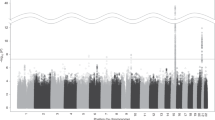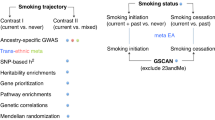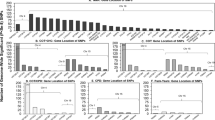Abstract
By running gene and pathway analyses for several smoking behaviours in the Tobacco and Genetics Consortium (TAG) sample of 74 053 individuals, 21 genes and several chains of biological pathways were implicated. Analyses were carried out using the HYbrid Set-based Test (HYST) as implemented in the Knowledge-based mining system for Genome-wide Genetic studies software. Fifteen genes are novel and were not detected with the single nucleotide polymorphism-based approach in the original TAG analysis. For quantity smoked, 14 genes passed the false discovery rate of 0.05 (corrected for multiple testing), with the top association signal located at the IREB2 gene (P=1.57E-37). Three genomic loci were significantly associated with ever smoked. The top signal is located at the noncoding antisense RNA transcript BDNF-AS (P=6.25E-07) on 11p14. The SLC25A21 gene (P=2.09E-08) yielded the top association signal in the analysis of smoking cessation. The 19q13 noncoding RNA locus exceeded the genome-wide significance in the analysis of age at initiation (P=1.33E-06). Pathways belonging to the Neuronal system pathways, harbouring the nicotinic acetylcholine receptor genes expressing the α (CHRNA 1-9), β (CHRNB 1-4), γ, δ and ɛ subunits, yielded the smallest P-values in the pathway analysis of the quantity smoked (lowest P=4.90E-42). Additionally, pathways belonging to ‘a subway map of cancer pathways’ regulating the cell cycle, mitotic DNA replication, axon growth and synaptic plasticity were found significantly enriched for genetic variants in ever smokers relative to never smokers (lowest P=1.61E-07). In addition, these pathways were also significantly associated with the quantity smoked (lowest P=4.28E-17). Our results shed light on one of the world's leading causes of preventable death and open a path to potential therapeutic targets. These results are informative in decoding the biological bases of other disease traits, such as depression and cancers, with which smoking shares genetic vulnerabilities.
This is a preview of subscription content, access via your institution
Access options
Subscribe to this journal
Receive 12 print issues and online access
$259.00 per year
only $21.58 per issue
Buy this article
- Purchase on Springer Link
- Instant access to full article PDF
Prices may be subject to local taxes which are calculated during checkout
Similar content being viewed by others
References
Organisation WHO. http://www.who.int/tobacco/health_priority/en/2015.
Ng M, Freeman MK, Fleming TD, Robinson M, Dwyer-Lindgren L, Thomson B et al. Smoking prevalence and cigarette consumption in 187 countries, 1980-2012. JAMA 2014; 311: 183–192.
Giovino GA, Mirza SA, Samet JM, Gupta PC, Jarvis MJ, Bhala N et al. Tobacco use in 3 billion individuals from 16 countries: an analysis of nationally representative cross-sectional household surveys. Lancet 2012; 380: 668–679.
Amos CI, Spitz MR, Cinciripini P . Chipping away at the genetics of smoking behavior. Nat Genet 2010; 42: 366–368.
Vink JM, Willemsen G, Boomsma DI . Heritability of smoking initiation and nicotine dependence. Behav Genet 2005; 35: 397–406.
Lubke GH, Hottenga JJ, Walters R, Laurin C, de Geus EJ, Willemsen G et al. Estimating the genetic variance of major depressive disorder due to all single nucleotide polymorphisms. Biol Psychiatry 2012; 72: 707–709.
Xian H, Scherrer JF, Madden PA, Lyons MJ, Tsuang M, True WR et al. The heritability of failed smoking cessation and nicotine withdrawal in twins who smoked and attempted to quit. Nicotine Tob Res 2003; 5: 245–254.
Bühler KM, Giné E, Echeverry‐Alzate V, Calleja‐Conde J, de Fonseca FR, López‐Moreno JA . Common single nucleotide variants underlying drug addiction: more than a decade of research. Addict Biol 2015; 20: 845–871.
Loukola A, Wedenoja J, Keskitalo-Vuokko K, Broms U, Korhonen T, Ripatti S et al. Genome-wide association study on detailed profiles of smoking behavior and nicotine dependence in a twin sample. Mol Psychiatry 2014; 19: 615–624.
Wang J, Li MD . Common and unique biological pathways associated with smoking initiation/progression, nicotine dependence, and smoking cessation. Neuropsychopharmacology 2010; 35: 702–719.
Liu JZ, Tozzi F, Waterworth DM, Pillai SG, Muglia P, Middleton L et al. Meta-analysis and imputation refines the association of 15q25 with smoking quantity. Nat Genet 2010; 42: 436–440.
Thorgeirsson TE, Gudbjartsson DF, Surakka I, Vink JM, Amin N, Geller F et al. Sequence variants at CHRNB3-CHRNA6 and CYP2A6 affect smoking behavior. Nat Genet 2010; 42: 448–453.
Tobacco and Genetics Consortium. Genome-wide meta-analyses identify multiple loci associated with smoking behavior. Nat Genet 2010; 42: 441–447.
Li M-X, Gui H-S, Kwan Johnny S, Sham Pak C . GATES: a rapid and powerful gene-based association test using extended simes procedure. Am J Hum Genet 2011; 88: 283–293.
Sham PC, Purcell SM . Statistical power and significance testing in large-scale genetic studies. Nat Rev Genet 2014; 15: 335–346.
Li M-X, Kwan JS, Sham PC . HYST: a hybrid set-based test for genome-wide association studies, with application to protein-protein interaction-based association analysis. Am J Hum Genet 2012; 91: 478–488.
Consortium TAG. Genome-wide meta-analyses identify multiple loci associated with smoking behavior. Nat Genet 2010; 42: 441–447.
Frazer KA, Ballinger DG, Cox DR, Hinds DA, Stuve LL, Gibbs RA et al. A second generation human haplotype map of over 3.1 million SNPs. Nature 2007; 449: 851–861.
Pritchard JK, Stephens M, Donnelly P . Inference of population structure using multilocus genotype data. Genetics 2000; 155: 945–959.
Price AL, Patterson NJ, Plenge RM, Weinblatt ME, Shadick NA, Reich D . Principal components analysis corrects for stratification in genome-wide association studies. Nat Genet 2006; 38: 904–909.
Bloom AJ, Hartz SM, Baker TB, Chen L-S, Piper ME, Fox L et al. Beyond Cigarettes Per Day. A Genome-Wide Association Study of the Biomarker Carbon Monoxide. Annals of the American Thoracic Society 2014; 11: 1003–1010.
David S, Hamidovic A, Chen G, Bergen A, Wessel J, Kasberger J et al. Genome-wide meta-analyses of smoking behaviors in African Americans. Translational psychiatry 2012; 2: e119.
Consortium GP. An integrated map of genetic variation from 1,092 human genomes. Nature 2012; 491: 56–65.
Database MS. [http://www.broadinstitute.org/gsea/msigdb/collection_details.jsp#CP].
Reactome. [http://www.reactome.org/].
KEGG. [http://www.genome.jp/kegg/].
BioCarta. [http://cgap.nci.nih.gov/Pathways/BioCarta_Pathways].
Benjamini Y, Hochberg Y . Controlling the false discovery rate: a practical and powerful approach to multiple testing. J R Stat Soc Series B Methodol 1995; 57: 289–300.
Laird NM, Lange C . The Fundamentals of Modern Statistical Genetics. Springer Science & Business Media: NY, 2011.
Welter D, MacArthur J, Morales J, Burdett T, Hall P, Junkins H et al. The NHGRI GWAS Catalog, a curated resource of SNP-trait associations. Nucleic Acids Res 2014; 42: D1001–D1006.
Consortium CADG. A genome-wide association study in Europeans and South Asians identifies five new loci for coronary artery disease. Nat Genet 2011; 43: 339–344.
Schwantes‐An TH, Culverhouse R, Duan W, Ramnarine S, Rice JP, Saccone NL . Interpreting joint SNP analysis results: when are two distinct signals really two distinct signals? Genet Epidemiol 2013; 37: 301–309.
Consortium SWGotPG. Biological insights from 108 schizophrenia-associated genetic loci. Nature 2014; 511: 421–427.
Lipovich L, Dachet F, Cai J, Bagla S, Balan K, Jia H et al. Activity-dependent human brain coding/noncoding gene regulatory networks. Genetics 2012; 192: 1133–1148.
Modarresi F, Faghihi MA, Lopez-Toledano MA, Fatemi RP, Magistri M, Brothers SP et al. Inhibition of natural antisense transcripts in vivo results in gene-specific transcriptional upregulation. Nat Biotechnol 2012; 30: 453–459.
Barrett JC, Fry B, Maller J, Daly MJ . Haploview: analysis and visualization of LD and haplotype maps. Bioinformatics 2005; 21: 263–265.
Chen D, Li Y, Wang L, Jiao K . SEMA6D expression and patient survival in breast invasive carcinoma. Int J Breast Cancer 2015; 2015: 10.
Tamagnone L . Emerging role of semaphorins as major regulatory signals and potential therapeutic targets in cancer. Cancer Cell 22: 145–152.
Uhl GR, Drgon T, Johnson C, Ramoni MF, Behm FM, Rose JE . Genome-wide association for smoking cessation success in a trial of precessation nicotine replacement. Mol Med 2010; 16: 513.
Vink JM, Smit AB, de Geus EJ, Sullivan P, Willemsen G, Hottenga J-J et al. Genome-wide association study of smoking initiation and current smoking. Am J Hum Genet 2009; 84: 367–379.
Nivard M, Verweij K, Minica C, Treur J, Consortium IC, Vink J et al. Connecting the dots, genome wide association studies in substance use. Mol Psychiatry 2016 (in press).
Loukola A, Buchwald J, Gupta R, Palviainen T, Hällfors J, Tikkanen E et al. A genome-wide association study of a biomarker of nicotine metabolism. PLoS Genet 2015; 11: e1005498.
Shannon P, Markiel A, Ozier O, Baliga NS, Wang JT, Ramage D et al. Cytoscape: a software environment for integrated models of biomolecular interaction networks. Genome Res 2003; 13: 2498–2504.
Benowitz NL . Nicotine addiction. N Engl J Med 2010; 362: 2295.
Li M, Zhang P . The function of APC/CCdh1 in cell cycle and beyond. Cell Div 2009; 4: 2.
Hahn WC, Weinberg RA . A subway map of cancer pathways. Nat Rev Cancer 2002 Nature Publishing Group.
Fisher R . Cigarettes, cancer, and statistics. Centennial Review of Arts & Science 1958; 2: 151–166.
VanderWeele TJ, Asomaning K, Tchetgen EJT, Han Y, Spitz MR, Shete S et al. Genetic variants on 15q25. 1, smoking, and lung cancer: an assessment of mediation and interaction. Am J Epidemiol 2012; 175: 1013–1020.
Diaz-Moralli S, Tarrado-Castellarnau M, Miranda A, Cascante M . Targeting cell cycle regulation in cancer therapy. Pharmacol Ther 2013; 138: 255–271.
Edwards AC, Kendler KS . A twin study of depression and nicotine dependence: shared liability or causal relationship? J Affect Disord 2012; 142: 90–97.
Dani JA, Harris RA . Nicotine addiction and comorbidity with alcohol abuse and mental illness. Nat Neurosci 2005; 8: 1465–1470.
Saccone NL, Culverhouse RC, Schwantes-An T-H, Cannon DS, Chen X, Cichon S et al. Multiple independent loci at chromosome 15q25. 1 affect smoking quantity: a meta-analysis and comparison with lung cancer and COPD. PLoS Genet 2010; 6: e1001053.
de Viron S, Morré SA, Van Oyen H, Brand A, Ouburg S . Genetic similarities between tobacco use disorder and related comorbidities: an exploratory study. BMC Medical Genet 2014; 15: 85.
Pers TH, Karjalainen JM, Chan Y, Westra H-J, Wood AR, Yang J et al. Biological interpretation of genome-wide association studies using predicted gene functions. Nat Commun 2015; 6: 5890.
Segrè AV, Groop L, Mootha VK, Daly MJ, Altshuler D, Consortium D et al. Common inherited variation in mitochondrial genes is not enriched for associations with type 2 diabetes or related glycemic traits. PLoS Genet 2010; 6: e1001058.
Network and Pathway Analysis Subgroup of Psychiatric Genomics Consortium. Psychiatric genome-wide association study analyses implicate neuronal, immune and histone pathways. Nat Neurosci 2015; 18: 199–209.
Jin L, Zuo X-Y, Su W-Y, Zhao X-L, Yuan M-Q, Han L-Z et al. Pathway-based analysis tools for complex diseases: a review. Genomics Proteomics Bioinformatics 2014; 12: 210–220.
Liu M, Fan R, Liu X, Cheng F, Wang J . Pathways and networks-based analysis of candidate genes associated with nicotine addiction. PLoS One 2015; 10: e0127438.
Baranzini SE, Galwey NW, Wang J, Khankhanian P, Lindberg R, Pelletier D et al. Pathway and network-based analysis of genome-wide association studies in multiple sclerosis. Hum Mol Genet 2009; 18: 2078–2090.
Wang K, Zhang H, Kugathasan S, Annese V, Bradfield JP, Russell RK et al. Diverse genome-wide association studies associate the IL12/IL23 pathway with Crohn Disease. Am J Hum Genet 2009; 84: 399–405.
Vinkhuyzen A, Wray N . Novel directions for G × E analysis in psychiatry. Epidemiol Psychiatr Sci 2015; 24: 12–19.
Acknowledgements
We thank the reviewers for their valuable comments on the manuscript. We thank the Tobacco and Genetics Consortium participants whose data we analysed in this study. We also thank the Tobacco and Genetics Consortium, all the researchers who contributed and lead this consortium. C.C.M., H.M. and J.M.V. are supported by the ERC starting grant 284167.
Author information
Authors and Affiliations
Corresponding author
Ethics declarations
Competing interests
The authors declare no conflict of interest.
Additional information
Supplementary Information accompanies the paper on the Molecular Psychiatry website
Supplementary information
Rights and permissions
About this article
Cite this article
Minicã, C., Mbarek, H., Pool, R. et al. Pathways to smoking behaviours: biological insights from the Tobacco and Genetics Consortium meta-analysis. Mol Psychiatry 22, 82–88 (2017). https://doi.org/10.1038/mp.2016.20
Received:
Revised:
Accepted:
Published:
Issue Date:
DOI: https://doi.org/10.1038/mp.2016.20
This article is cited by
-
New and sex-specific migraine susceptibility loci identified from a multiethnic genome-wide meta-analysis
Communications Biology (2021)
-
Genome-wide association meta-analysis of nicotine metabolism and cigarette consumption measures in smokers of European descent
Molecular Psychiatry (2021)



